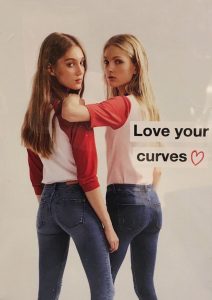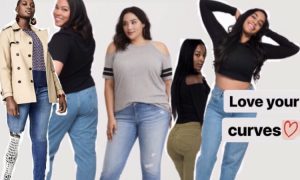CULTURE JAM ASSIGNMENT
by Eleanor Yang
ORIGINAL ADVERTISEMENT

Zara “Love your curves” advertisement (Gonazález Cruz, 2017).
WRITTEN ANALYSIS OF ORIGINAL ADVERTISEMENT
This is an advertisement for women’s jeans at Zara (a clothing store). The slogan “Love your curves” has caused a lot of controversy and received significant negative backlash, as it is telling customers to embrace their curves and show them off, despite the fact that the picture features two skinny models. While this is not to say that skinny women cannot have curves and be proud of their assets, it is clear that Zara chose to feature skinny women, which is traditional of the fashion industry, in their campaign rather than use the opportunity to feature average or fuller and curvier bodies. It should also be noted that the two models chosen are Caucasian, which shows the lack of representation in the fashion industry.
Additionally, the already slim models in the advertisement seem to have been photoshopped to appear thinner and less shapely. This is evident in their larger head size, as their heads and bodies seem to not be proportional, and their awkwardly positioned knees. While heavy editing is prevalent in the fashion industry, it is extremely harmful, as it places unhealthy and unattainable expectations on body image. Furthermore, by featuring models that look like pre-teens or teenagers, an unhealthy and unrealistic body standard is being promoted to impressionable younger girls. This obsession with slim figures consequently results in the shaming of average and fuller figures, which are never represented in media as they are deemed not beautiful.
In a society that has only embraced women with skinny bodies, it is a huge leap for women with fuller bodies when clothing brands are more inclusive and create clothing that not only embraces, but celebrates curvy bodies. Since most advertisers use bodies traditional of the fashion industry, meaning skinny and tall models, fuller-bodies are less represented and are therefore less praised and equated with beauty. By excluding average or fuller-bodied women, this advertisement does not conjure up the body positivity that embracing curves should and in fact does the opposite, by feeding into body insecurities that shame and project unhealthy and unrealistic beauty expectations on women and young girls.
JAMMED VERSION OF ADVERTISEMENT

Jammed version of advertisement (Buzzfeed, 2016) (PZI Jeans, 2015) (Torrid, 2018).
WRITTEN EXPLANATION OF JAMMING PHILOSOPHY
Zara’s original advertisement had the potential to promote body positivity and uplift average and fuller-bodied women in an industry where they are often not represented or deemed beautiful in. However, because it failed to do so, I wanted to alter it.
Originally, I wanted to make the two models a little fuller, as they were photoshopped to be slimmer. I also wanted to add fuller-bodied models, of different ethnicities, to promote different representations of beauty. I wanted to show that curves could be attached to thinner women and fuller-bodied women and be beautiful on all women. However, I decided to only use fuller-bodied women, because voluptuous bodies are more commonly associated with curves and they are less represented in the media as beautiful.
For the jammed advertisement, I tried to keep it similar to the original advertisement. I edited several fuller-bodied women and included a model with a prosthetic leg, to show that inclusion needs to extend beyond able-bodied representations. Furthermore, the models in the jammed advertisement exude happiness, unlike in the original advertisement, and confidence in their bodies that the “Love your curves” tagline is meant to evoke. There was also no additional slimming of models in this advertisement, unlike in the original.
My alterations were meant to show that we must be more critical about how women and their bodies are represented, or not represented, in media, as these portrayals affect beauty standards and body image. We should not be projecting unattainable, photoshopped images onto impressionable women and girls and we should be inclusive in our representations of women and girls. This includes using models of different body sizes, types and ethnicities. The lack of representation in media has resulted in certain bodies being deemed not beautiful and has created an unattainable standard of beauty for women and young girls. By using ethnic models with body types not usually seen in the media, I am hoping that my new jammed advertisement shows that there needs to be more criticism about how women and their bodies are represented to ensure healthier and more inclusive beauty standards.
BIBLIOGRAPHY
Buzzfeed. (2016). We Tried Mom Jeans And We Were Surprised AF. [Photograph]. Retrieved from https://www.buzzfeed.com/kristinchirico/we-tried-mom-jeans-and-they-were-surprisingly-great?utm_term=.urB57A1K9#.aqGNGo8KV
Gonazález Cruz, A. (Writer). (2017). Love your curves advertisement. [Photograph]. Retrieved from https://www.femina.se/kritikstorm-mot-zaras-kampanj-for-kurviga-ni-maste-skamta/
Komar, M. (Writer). (2018). Tommy Hilfiger’s Spring 2018 Adaptive Clothing Line. [Photograph]. Retrieved from https://www.bustle.com/p/tommy-hilfigers-spring-2018-adaptive-clothing-line-was-designed-especially-for-people-with-disabilities-8702382
PZI Jeans. (2015). Curvy Denim Line For Women Seeking Fresh Faces For 2016 Campaign. [Photograph]. Retrieved from http://www.blacknews.com/news/pzi-jeans-national-curvy-girl-model-search/#.WzRQIRJKhE4
Torrid. (2018). Cropped Boyfriend Jean – Distressed Light Wash. [Photograph]. Retrieved from https://www.torrid.com/product/cropped-boyfriend-jean—distressed-light-wash/1125 9427.html?cgid=jeans-all#sz=180&start=177